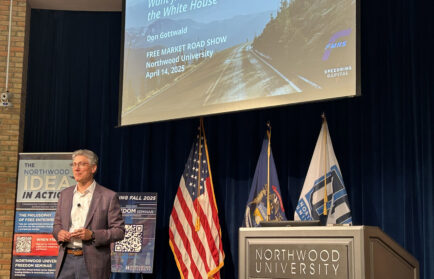By Riley Hayer
The U.S. Dollar (USD) is considered the world reserve currency, but what does that mean? A world reserve currency is a currency utilized across the globe in central banks and financial institutions for transactions, debt obligations, or to influence those countries’ domestic exchange rates.
For central banks to hold the world reserve currency, that country must conduct trade with, in today’s case, the United States in USD. This has been the case since 1944. It shifted from the United Kingdom’s pound sterling to the USD amidst World War II. For the last 79 years, the United States has remained the dominant world reserve currency, but its position of power is not without competition. The USD is facing competition from the Chinese yuan, euro, cryptocurrencies, BRICS proposed R5, and the option of a multi-currency reserve system. But are any of these competitors capable of replacing the USD as the world reserve currency?
The USD became the world reserve currency in 1944 due to the Bretton Woods Agreement made during World War II.
At the time of the war, the United States was a global superpower both in military and economic stature. It made sense for countries to adopt the USD as their reserve currency because of the United States’ free market, transparency, economic strength, and the gold standard.
At a convention in Bretton Woods, New Hampshire, 44 nations agreed to adopt the USD and its gold standard as their reserve currency.
This was a great economic advantage for many years in the United States until the 1970s, when the dollar transitioned away from the gold standard into fiat money. Without the gold standard, the Bretton Woods Agreement collapsed, yet many countries continued to use the USD as their reserve currency. The continued use of the USD as the world reserve currency is for a multitude of reasons.
The United States fulfilled all the requirements of a strong reserve currency. These requirements are as follows:
• Large economy
• Vast international presence
• Open financial markets
During the 70s, like the present day, the United States was a global powerhouse. The free market allowed countries across the globe to acquire the USD easily. They had confidence in the USD because of the size and strength of the United States economy. The combination of these factors, backed by the inertia of almost 30 years, continues to propel the USD as the world reserve currency.
The USD’s position as the world reserve currency comes with many benefits. These include global acceptance, lower prices for domestic consumers of foreign goods, and global economic influence. The USD is so widely recognized among countries that it can be used to finance purchases between countries across the globe. The wide use and acceptance means there are no conversion costs between the USD and another country’s currency. That is what keeps prices lower for U.S. domestic consumers purchasing foreign goods. The United States’ influence on international trade shows in a couple of ways. It can be used to persuade further investment in the United States, but it can also be utilized to dissuade countries from certain actions. An example of this is the use of sanctions against Russia since its invasion of Ukraine. This has frozen roughly $100 billion worth of assets in the Central Russian Bank.
While the United States reaps many benefits from being the world reserve currency, many challenge its position. These challengers are the euro, Chinese yuan, BRICS R5, and cryptocurrency.
The euro is a currency backed by the countries within the European Union. This allows for a diversified portfolio of countries backing the euro. It is the second most-held reserve currency in the world. The International Monetary Fund determined there are roughly $2.3 trillion claims for the EU compared to the United States’ claim of $6.5 trillion. In 2022, as reported by the IMF, the EU’s GDP was roughly $16.6 trillion, and the US’s GDP was $25.5 trillion. The United States has a greater expanse of influence in the global economy, but it also has a significantly stronger economy compared to the European Union.
China is the second largest economy in the world and its influence spans the global economy. According to the IMF, China’s GDP in 2022 was $18.1 trillion. It fills some of the requirements to be a strong reserve currency, but not all of them. China is not a free market economy. Many of their companies are overseen by the government, making the financial markets closed off to foreign markets.
Additionally, while their influence spans the globe in products, they are not financially influential. The Chinese yuan only makes up $298 billion in claims of reserve currency. This is only 2.69% of the world’s reserve currency. Although the Chinese economy is the second largest in the world and its influence spans across the globe, other countries have yet to put much faith in the yuan as a reserve currency.
That’s where our third challenger comes in: BRICS. BRICS is a group of the following countries: Brazil, Russia, India, China, and South Africa. These five countries have proposed R5, a currency backed by the currencies of the five countries that make up BRICS, in addition to the surrounding country’s currency. R5 is only in discussion at this point. It is nothing more than a concept. However, if established, it can emulate the European Union’s euro. It is close to the same concept with a different compilation of countries. It is a diversified portfolio of countries backed by the second-largest economy on the globe. There is a possibility that R5 becomes one of the largest claims in the world reserve currency. It needs to become more than a concept for this to occur.
Cryptocurrency, another possible challenger to the USD’s position as the world reserve currency, is still new to most. It allows for a public ledger of transactions. This eliminates the capability for privacy and fraudulent activity utilizing it. Cryptocurrency is a decentralized security, which makes it difficult for one country to exercise control over it. This lack of privacy and lack of control deters countries from utilizing cryptocurrency as a reserve currency. This is not to say that cryptocurrency may never be utilized as a reserve currency, but it does not have much traction individually for transactions, let alone globally.
In conclusion, the USD’s position as the world reserve currency is firmly entrenched, backed by its historical dominance and the range of advantages it offers. The USD’s global acceptance and influence have allowed for seamless transactions, lower prices for domestic consumers on foreign goods, and the ability to exert economic influence on a global scale. In the face of its many challenges, the USD maintains its dominant position due to its economic strength, global market acceptance, and long-standing inertia.
However, the global reserve currency landscape is dynamic and subject to change. The emergence of new economic powers and evolving financial technologies may shape the future of reserve currencies. Continual monitoring and analysis are essential to understand the implications and potential scenarios that may unfold, as the world economy evolves in the coming years.
ABOUT THIS AUTHOR
Riley Hayer is an undergraduate honors student at Northwood University, where he majors in finance and minors in data analytics, and excels in the accelerated BBA/MBA program. Riley is a leading member of the nationally-ranked Mock Trial team, and serves as finance chair on the executive board of the acclaimed Northwood University International Auto Show. Riley and his family live in Clare, Michigan, and enjoy skiing, backpacking, and exploring the wonders of Michigan. In his free time, he enjoys playing computer games, reading, and being outdoors.




